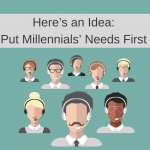The Human Element: Balancing Employee Experience in the Age of Workforce Optimization

Let’s be honest—put your hand up if you grew up wanting to be a contact center agent. No? Nobody? We get it. Our industry has gotten a bad rap from some true horror stories, and the stigma sticks to all of us in some way or another.
That’s why at Blue Ocean, we’re so dead-set on defying that stereotype and placing employee experience at the center of everything we do. But as we’ve discussed before, prioritizing employee experience can inadvertently spark discord between workforce management (WFM) and other departments. Understanding these dynamics is key to creating a contact center where both operational efficiency and employee engagement can thrive.
Here’s what we’ve learned about the crucial role employee experience plays when balancing operational demands and human needs:
1. Standard Shifts: Where Employee Life Meets Business Reality
It’s human nature to gravitate towards routine. People generally like to know what their schedules will look like from one week to the next, especially their work schedule, so they can coordinate their lives, weekends, family obligations, and hobbies. That’s why standard shifts are a powerful tool for employee experience; they make it easier to attract and retain great agents when you can offer some semblance of work-life balance.
Of course, standard shifts make the workforce management team want to bang their heads on their desks (we see you, WFM folks!). They need to meet forecasted call volumes in the most efficient manner possible. Contact arrival patterns are driven by unpredictable triggers like weather or supply chain problems. Volumes vary by time of day, day of the week, and by season. There’s nothing “standard” about any of it, which is why WFM prefers staggered shifts, split shifts, and part-time shifts for maximum efficiency.
The employee experience sweet spot? Finding scheduling approaches that balance predictability for agents with the flexibility required to meet service levels. When employees feel their personal lives are respected, they bring that positivity to customer interactions.
2. Finding Common Ground in What We Measure
Workforce Management needs to meet contracted levels of service, efficiency goals, and productivity targets while analyzing their team’s ability to hit critical KPIs. Nowhere in their traditional mandate is the requirement to make it a good experience for the agent.
But here’s the reality: big-picture success for both client and contact center relies on employee engagement and retention of successful, striving agents who are committed to their client brand. That means success must be measured not just by service levels but by retention rates, referrals, and engagement scores.
At Blue Ocean, we’ve learned that how you treat people has everything to do with the quality of their work and their commitment to show up—both physically and mentally. We focus on ensuring agents feel heard, have input on their schedules, and are happy in their work environments. Our goal is developing strategies that result in agents feeling empowered to make a difference every time they interact with a customer.
On the flip side, as a workforce team member who shall remain nameless once said, “Service Level doesn’t care who answers the phone…” The cliché is true: what gets measured gets done. The employee experience breakthrough happens when everyone appreciates each other’s measurements and finds common ground.
3. Self-Management: The Employee Empowerment Advantage
Process is important. It drives consistency in the customer experience. But there’s a sweet spot between the micro-management that inevitably becomes part of process and the self-management that occurs when you empower your agents.
Process will successfully deliver 80% of customer experience. The other 20%—the part that truly differentiates your service—comes when agents are able to make autonomous decisions about the best way to steward a client’s resources. Ultimately, focusing on employee experience by giving agents appropriate decision-making authority is the best path to taking care of the client.
Agents who feel trusted and empowered deliver better customer experiences, period. That’s why improving employee experience through autonomy actually enhances operational results rather than compromising them.
4. Productivity as the Natural Outcome of Engagement
When employee experience is prioritized, productivity isn’t forced—it emerges naturally. Productivity becomes the natural outcome of engagement, of hiring the right people, and of treating them with respect. When people know they matter, they want to be work-ready. And being work-ready is exactly what WFM needs.
If an agent is under-productive, maybe their employment experience is contributing to disengagement, or perhaps they aren’t a good match for the position. That’s why we’re so focused on determining the best contact center agent profile to recruit, and then creating a positive experience that keeps them engaged and productive.
These approaches work toward the same goal that WFM has: having the right people, in the right place, doing the right things, at the right time. Finding common ground in this shared goal is vital to call center success.
Bonus: How AI Is Reshaping the Employee Experience Equation
Let’s talk about the elephant in the contact center: artificial intelligence. As AI tools become increasingly prevalent in customer experience, they’re dramatically reshaping the employee experience equation.
Here’s a painful truth we’ve learned from years in the CX trenches: the best AI technology in the world is worthless if its implementation ignores the agent experience. Companies often invest millions in cutting-edge solutions only to create digital monsters that frustrate agents and ultimately alienate customers.
The most common mistake? Starting with the solution instead of the problem. Before implementing AI tools that affect your agents’ daily work, get crystal-clear about what you’re trying to accomplish. What pain points are you solving for your team? How will this technology enhance—not just change—their work experience?
For agents, we emphasize how AI enhances rather than replaces their work. By removing repetitive tasks, the remaining work becomes more engaging and better utilizes their skills. There’s understandable fear around AI taking jobs, but that’s not how it typically plays out in well-designed systems. When mindless tasks disappear, what remains is more meaningful work that requires the uniquely human skills of empathy, critical thinking, and relationship building.
The key is involving agents early in the implementation process:
- Engage them as early adopters who can provide invaluable feedback on usability
- Make them champions who understand the benefits and can advocate to their peers
- Listen to their concerns about workflow changes or tool functionality
- Adapt training approaches based on their real-world experience with the technology
This collaborative approach creates a virtuous cycle: when agents feel their input matters in technology decisions, engagement increases. When engagement increases, they’re more likely to embrace new tools. When they embrace new tools effectively, customer experience improves. And when customer experience improves, agent satisfaction rises as they have more positive interactions.
By focusing on how AI can enhance employee experience—not just operational metrics—you transform what could be a source of anxiety into a competitive advantage for your contact center.
Achieving the Balanced Contact Center
Workforce management has traditionally focused on operational efficiency rather than employee engagement. However, we’ve discovered that these two priorities aren’t mutually exclusive—they’re complementary. When employee experience becomes a shared priority across departments, overall contact center success follows naturally.
At Blue Ocean, we’re committed to balancing the human elements that produce quality and commitment while supporting the efficiency and productivity goals of our WFM team. It’s how we deliver a differentiated experience for all parties involved: our clients, our clients’ customers, and our own employees.
The secret to exceptional customer service isn’t hiding in elaborate processes or advanced technologies—it’s in creating an employee experience where agents feel valued, empowered, and engaged. As we’ve seen, this principle remains true even as AI transforms the contact center landscape. When we get employee experience right, everything else falls into place.
Looking for a partner that can help you find the right balance?




